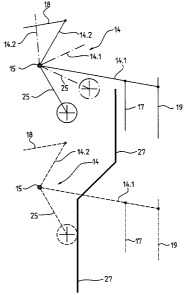Une partie des informations de ce site Web a été fournie par des sources externes. Le gouvernement du Canada n'assume aucune responsabilité concernant la précision, l'actualité ou la fiabilité des informations fournies par les sources externes. Les utilisateurs qui désirent employer cette information devraient consulter directement la source des informations. Le contenu fourni par les sources externes n'est pas assujetti aux exigences sur les langues officielles, la protection des renseignements personnels et l'accessibilité.
L'apparition de différences dans le texte et l'image des Revendications et de l'Abrégé dépend du moment auquel le document est publié. Les textes des Revendications et de l'Abrégé sont affichés :
| (12) Brevet: | (11) CA 2404677 |
|---|---|
| (54) Titre français: | DISPOSITIF DE BLOCAGE DU FREIN DE SECURITE D'UN ASCENSEUR |
| (54) Titre anglais: | DEVICE FOR BLOCKING A SAFETY BRAKE FOR LIFT |
| Statut: | Réputé périmé |
| (51) Classification internationale des brevets (CIB): |
|
|---|---|
| (72) Inventeurs : |
|
| (73) Titulaires : |
|
| (71) Demandeurs : |
|
| (74) Agent: | RICHES, MCKENZIE & HERBERT LLP |
| (74) Co-agent: | |
| (45) Délivré: | 2010-07-20 |
| (22) Date de dépôt: | 2002-09-24 |
| (41) Mise à la disponibilité du public: | 2003-03-28 |
| Requête d'examen: | 2007-07-10 |
| Licence disponible: | S.O. |
| (25) Langue des documents déposés: | Anglais |
| Traité de coopération en matière de brevets (PCT): | Non |
|---|
| (30) Données de priorité de la demande: | ||||||
|---|---|---|---|---|---|---|
|
Dans cet ascenseur, une cabine (2) descend jusqu'à un arrêt, prévu au niveau inférieur. Si la cabine (2) ne s'arrête pas au niveau inférieur comme prévu, des amortisseurs (26) immobilisent la cabine (2) après qu'elle a dépassé sa course nominale. En pareil cas, un frein de sécurité (16) peut se déclencher du fait de l'inertie d'un limiteur de vitesse (13) et d'un câble de freinage (19). Pour éviter le déclenchement intempestif du frein de sécurité (16), en cas de course jusqu'aux amortisseurs, la gaine d'ascenseur (1) est pourvue d'un élément de verrouillage (27) qui empêche le déplacement d'un levier de blocage (25) dès que la cabine (2) dépasse le niveau inférieur. Étant immobilisé, le levier de blocage (25) verrouille un double levier (14) et, grâce à une timonerie (18), un autre double levier (14). Le déclenchement du frein de sécurité (16) est ainsi interdit.
In this lift equipment a lift cage (2) is on the way down, wherein a halt at the bottom storey is scheduled. If the lift cage (2) does not halt at the bottom storey according to plan, the lift cage (2) in its further travel is caught by buffers (26). In that case a safety brake (16) can be tripped due to the inertia of a speed limiter (13) and a limiter cable (19). So that the undesired tripping of the safety brake (16) can be avoided in the case of buffer travel, there is provided in the lift shaft (1) a blocking element (27) which blocks the movement of a blocking lever (25) as soon as the lift cage (2) has gone down past the bottom storey. The blocked blocking lever (25) blocks one double lever (14) and, by way of a linkage (18), the other double lever (14). Tripping of the safety brake (16) is thus precluded.
Note : Les revendications sont présentées dans la langue officielle dans laquelle elles ont été soumises.
Note : Les descriptions sont présentées dans la langue officielle dans laquelle elles ont été soumises.

Pour une meilleure compréhension de l'état de la demande ou brevet qui figure sur cette page, la rubrique Mise en garde , et les descriptions de Brevet , États administratifs , Taxes périodiques et Historique des paiements devraient être consultées.
| Titre | Date |
|---|---|
| Date de délivrance prévu | 2010-07-20 |
| (22) Dépôt | 2002-09-24 |
| (41) Mise à la disponibilité du public | 2003-03-28 |
| Requête d'examen | 2007-07-10 |
| (45) Délivré | 2010-07-20 |
| Réputé périmé | 2013-09-24 |
Il n'y a pas d'historique d'abandonnement
| Type de taxes | Anniversaire | Échéance | Montant payé | Date payée |
|---|---|---|---|---|
| Enregistrement de documents | 100,00 $ | 2002-09-24 | ||
| Le dépôt d'une demande de brevet | 300,00 $ | 2002-09-24 | ||
| Taxe de maintien en état - Demande - nouvelle loi | 2 | 2004-09-24 | 100,00 $ | 2004-08-25 |
| Taxe de maintien en état - Demande - nouvelle loi | 3 | 2005-09-26 | 100,00 $ | 2005-08-29 |
| Taxe de maintien en état - Demande - nouvelle loi | 4 | 2006-09-25 | 100,00 $ | 2006-08-31 |
| Requête d'examen | 800,00 $ | 2007-07-10 | ||
| Taxe de maintien en état - Demande - nouvelle loi | 5 | 2007-09-24 | 200,00 $ | 2007-08-30 |
| Taxe de maintien en état - Demande - nouvelle loi | 6 | 2008-09-24 | 200,00 $ | 2008-08-27 |
| Taxe de maintien en état - Demande - nouvelle loi | 7 | 2009-09-24 | 200,00 $ | 2009-08-27 |
| Taxe finale | 300,00 $ | 2010-05-04 | ||
| Taxe de maintien en état - brevet - nouvelle loi | 8 | 2010-09-24 | 200,00 $ | 2010-09-09 |
| Taxe de maintien en état - brevet - nouvelle loi | 9 | 2011-09-26 | 200,00 $ | 2011-09-08 |
Les titulaires actuels et antérieures au dossier sont affichés en ordre alphabétique.
| Titulaires actuels au dossier |
|---|
| INVENTIO AG |
| Titulaires antérieures au dossier |
|---|
| HUGEL, STEFAN |
| MAURY, JULIEN |